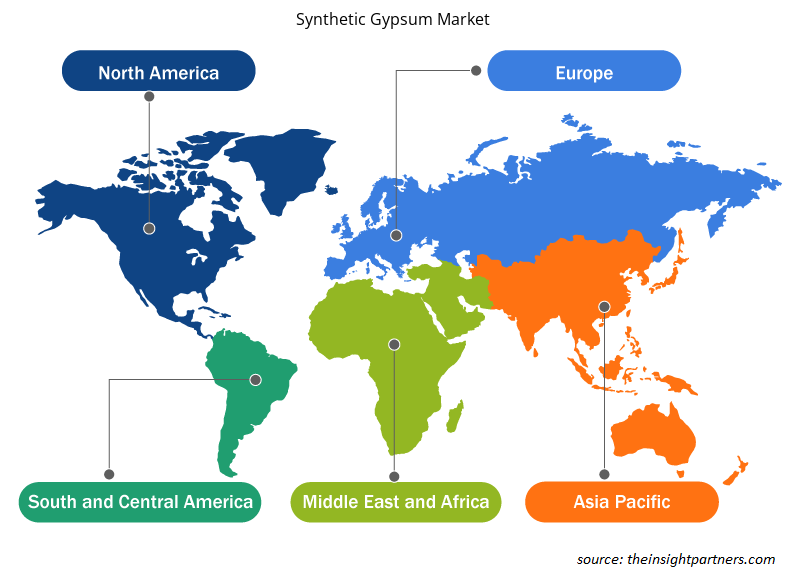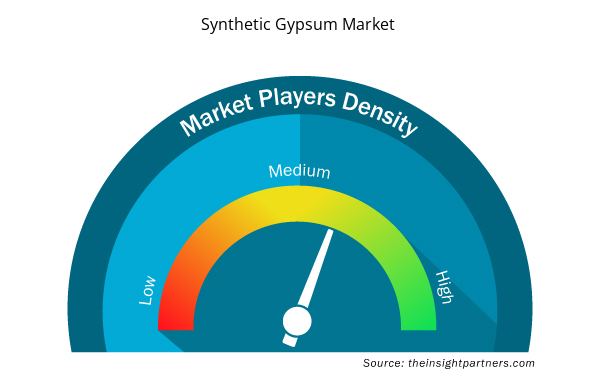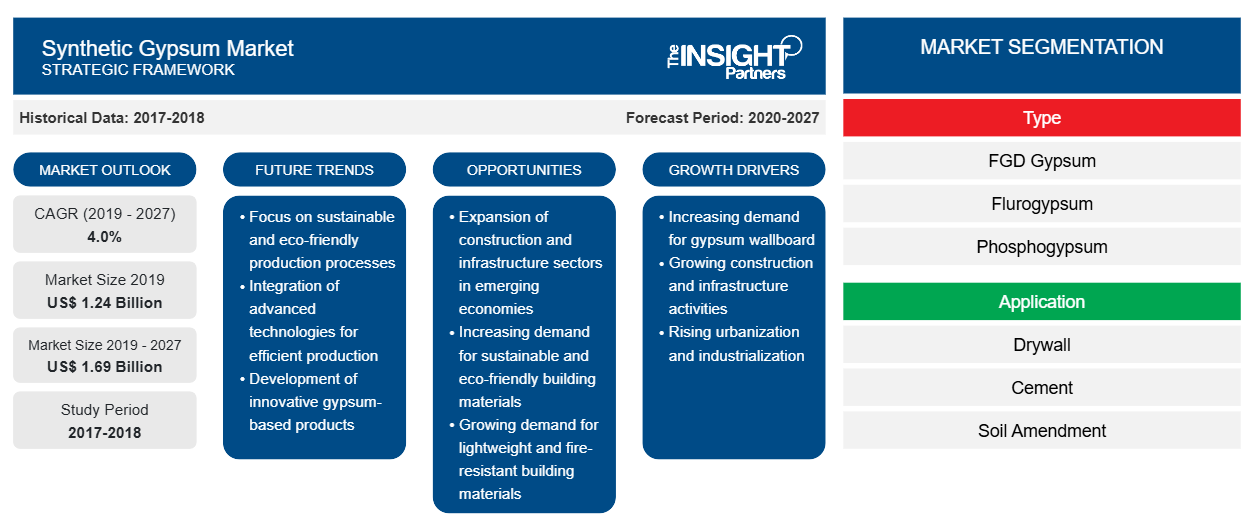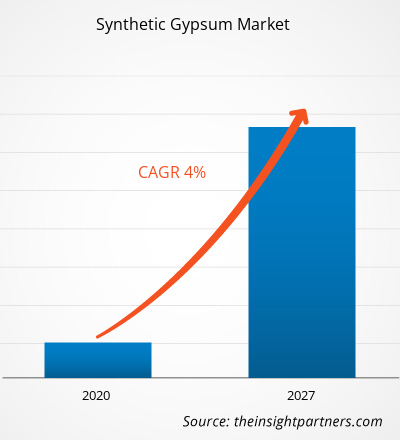[Rapporto di ricerca] Il mercato globale del gesso sintetico è stato valutato a 1.244,02 milioni di dollari nel 2019 e si prevede che raggiungerà 1.693,72 milioni di dollari entro il 2027; si prevede che crescerà a un CAGR del 4,0% dal 2020 al 2027.
Il gesso sintetico è utilizzato principalmente nell'edilizia e nell'industria agricola. La crescita dell'industria edile in tutto il mondo ha aumentato la domanda di strutture decorative e cartongesso, il che ha spinto la domanda di gesso sintetico. Inoltre, l'uso di gesso sintetico come riempitivo nel processo di produzione del cemento rafforza la crescita del mercato del gesso sintetico.
Nel 2019, il Nord America ha contribuito alla quota maggiore del mercato globale del gesso sintetico. La crescita del mercato nel Nord America è attribuita alla crescita del settore edile negli Stati Uniti e all'emergere di varie aziende di sistemi FGD nel Nord America. A causa della crescente urbanizzazione e industrializzazione, le attività di costruzione nella regione stanno aumentando. Ciò sta stimolando la domanda di progetti di rinnovamento urbano, che sta spingendo la domanda di gesso sintetico utilizzato per realizzare cemento, cartongesso e strutture decorative.
L'epidemia di COVID-19 sta influenzando negativamente le economie e le industrie in vari paesi a causa di blocchi, divieti di viaggio e chiusure aziendali. L'industria chimica e dei materiali globale è una delle principali industrie che subisce gravi interruzioni come interruzioni della catena di fornitura, cancellazioni di eventi tecnologici e chiusure di uffici. Ad esempio, la Cina è il polo manifatturiero globale e il più grande fornitore di materie prime per vari settori, ed è anche uno dei paesi più colpiti. Il blocco di vari impianti e fabbriche in Cina sta limitando le catene di fornitura globali e interrompendo le attività di produzione, i programmi di consegna e le varie vendite di prodotti chimici e materiali. Diverse aziende hanno già annunciato possibili ritardi nelle consegne dei prodotti e un crollo delle vendite future dei loro prodotti. Inoltre, i divieti di viaggio globali imposti dai paesi in Europa, Asia e Nord America stanno ostacolando le collaborazioni aziendali e le opportunità di partnership. Tutti questi fattori stanno ostacolando l'industria chimica e dei materiali e quindi agiscono come fattori limitanti per la crescita di vari mercati correlati a questo settore.
Personalizza questo report in base alle tue esigenze
Riceverai la personalizzazione gratuita di qualsiasi report, comprese parti di questo report, o analisi a livello nazionale, pacchetto dati Excel, oltre a usufruire di grandi offerte e sconti per start-up e università
- Scopri le principali tendenze di mercato in questo rapporto.Questo campione GRATUITO includerà analisi di dati che spaziano dalle tendenze di mercato alle stime e alle previsioni.
Approfondimenti di mercato
Domanda crescente nel settore delle costruzioni
La domanda di gesso sintetico è in aumento nel settore edile. Nel settore edile, il gesso sintetico è utilizzato principalmente come materiale di riempimento per il cemento e gli intonaci per aumentarne la resistenza e anche per ridurre il tempo di presa del calcestruzzo. Viene anche utilizzato per realizzare pannelli decorativi e gesso di Parigi. Il gesso FGD, che è uno dei tipi di gesso sintetico, è utilizzato principalmente nel settore edile per produrre cemento, cartongesso e gesso di Parigi. Il gesso FGD è fondamentalmente riciclabile in natura e quindi è utilizzato principalmente dai produttori. Il gesso di Parigi è fondamentalmente utilizzato per realizzare pannelli decorativi, strutture e sculture. La domanda di queste strutture e sculture è in aumento nel settore edile, il che sta portando a un aumento della domanda di gesso sintetico. I governi di molti paesi in via di sviluppo si stanno concentrando sullo sviluppo e il miglioramento delle loro infrastrutture e stanno introducendo molte riforme e normative che aiuteranno a dare impulso ai settori immobiliare e infrastrutturale. Si prevede che tutte queste normative e riforme avranno un impatto positivo sul settore delle costruzioni, il che stimolerà la domanda di gesso sintetico nel periodo di previsione.paris. FGD gypsum, which is one of the types of synthetic gypsum, is mainly used in the construction industry to manufacture cement, drywall, and plaster of paris. FGD gypsum is basically recyclable in nature and thus, is mostly used by the manufacturers. Plaster of Paris is basically used for making decorative panels, structures, and sculptures. The demand for these structures and sculptures are increasing in the construction industry, which is leading to an increase in the demand of synthetic gypsum. The governments of many developing countries are focusing on developing and improving their infrastructure and are introducing many reforms and regulations that will help in boosting the real-estate and infrastructure industries. All these regulations and reforms are expected to have a positive impact on the construction industry, which would boost the demand for synthetic gypsum in the forecast period.
Tipo Informazioni
In base al tipo, il mercato del gesso sintetico è segmentato in gesso FGD, fluorogesso, fosfogesso, citrogesso e altri. Il segmento del gesso FGD ha guidato il mercato con la quota maggiore nel 2019.FGD gypsum, Flurogypsum, Phosphogypsum, Citrogypsum, and Others. The FGD gypsum segment led the market with the largest share in 2019. Il gesso FGD è fondamentalmente il gesso ottenuto dai sistemi di desolforazione dei gas di combustione. Lo zolfo viene rimosso principalmente dai gas di combustione, il che può essere fatto tramite l'aiuto della calce nel sistema di desolforazione dei gas di combustione. Il gesso FGD ha principalmente la stessa identità chimica di un gesso naturale ed è considerato un gesso di maggiore purezza. L'uso del gesso FGD è considerato ecologicamente vantaggioso. Il gesso FGD ha applicazioni agricole e può essere utilizzato in condizioni idrogeologiche e del suolo allo scopo di preservare il suolo e riciclare i materiali industriali. Il processo attraverso il quale viene prodotto il gesso FGD è ecologico e fornisce una fonte ecologica di gesso puro. Il gesso FGD ha varie applicazioni in processi quali produzione di cemento, trattamento delle acque, fabbricazione del vetro, applicazioni minerarie, prodotti in pannelli di gesso, costruzione di autostrade e agricoltura. Può anche essere utilizzato come fonte di nutrimento per le colture. gypsum is basically the gypsum obtained from the flue gas desulfurization systems. The sulfur is mostly removed from the flue gas, which can be done through the help of lime in the flue gas desulfurization system. The FGD gypsum mostly has the same chemical identity as that of a natural gypsum, and it is considered as a gypsum of greater purity. The use of FGD gypsum is considered as ecologically beneficial. FGD gypsum has agricultural applications and can be used in soil and hydrogeologic conditions for the purpose of soil conservation and industrial material recycling. The process through which FGD gypsum is manufactured is eco-friendly and provides an ecological source of pure gypsum. FGD gypsum has various applications in processes such as cement production, water treatment, glass making, mining applications, gypsum panel products, highway construction, and agriculture. It can also be used as a source of nutrition for crops.
Alcuni attori chiave del mercato che operano nel mercato del gesso sintetico sono Drax Group PLC, American Gypsum, USG Corporation, Larargeholcim, Travancore Titanium Products Limited, Knauf Gips KG, Transparent Tehcnologies Limited, BauMineral GMBH, Steag GMBH e Boral. I principali attori del mercato si stanno concentrando su strategie quali fusioni e acquisizioni e lanci di prodotti per espandere la loro presenza geografica e la base di consumatori a livello globale. Drax Group PLC, American Gypsum, USG Corporation, Larargeholcim, Travancore Titanium Products Limited, Knauf Gips KG, Transparent Tehcnologies Limited, BauMineral GMBH, Steag GMBH, and Boral. Major players in the market are focusing on strategies such as mergers and acquisitions, and product launches to expand their geographical presence and consumer base globally.
Approfondimenti regionali sul mercato del gesso sintetico
Le tendenze regionali e i fattori che influenzano il mercato del gesso sintetico durante il periodo di previsione sono stati ampiamente spiegati dagli analisti di Insight Partners. Questa sezione discute anche i segmenti e la geografia del mercato del gesso sintetico in Nord America, Europa, Asia Pacifico, Medio Oriente e Africa e America meridionale e centrale.

- Ottieni i dati specifici regionali per il mercato del gesso sintetico
Ambito del rapporto sul mercato del gesso sintetico
| Attributo del report | Dettagli |
|---|---|
| Dimensioni del mercato nel 2019 | 1,24 miliardi di dollari USA |
| Dimensioni del mercato entro il 2027 | 1,69 miliardi di dollari USA |
| CAGR globale (2019 - 2027) | 4,0% |
| Dati storici | 2017-2018 |
| Periodo di previsione | 2020-2027 |
| Segmenti coperti | Per tipo
|
| Regioni e Paesi coperti | America del Nord
|
| Leader di mercato e profili aziendali chiave |
|
Densità degli attori del mercato del gesso sintetico: comprendere il suo impatto sulle dinamiche aziendali
Il mercato del gesso sintetico sta crescendo rapidamente, spinto dalla crescente domanda degli utenti finali dovuta a fattori quali l'evoluzione delle preferenze dei consumatori, i progressi tecnologici e una maggiore consapevolezza dei benefici del prodotto. Con l'aumento della domanda, le aziende stanno ampliando le loro offerte, innovando per soddisfare le esigenze dei consumatori e capitalizzando sulle tendenze emergenti, il che alimenta ulteriormente la crescita del mercato.
La densità degli operatori di mercato si riferisce alla distribuzione di aziende o società che operano in un particolare mercato o settore. Indica quanti concorrenti (operatori di mercato) sono presenti in un dato spazio di mercato in relazione alle sue dimensioni o al valore di mercato totale.
Le principali aziende che operano nel mercato del gesso sintetico sono:
- Gruppo Drax PLC
- Gesso americano
- Società USG
- Largaholcim
- Prodotti in titanio Travancore Limited
Disclaimer : le aziende elencate sopra non sono classificate secondo un ordine particolare.

- Ottieni una panoramica dei principali attori del mercato del gesso sintetico
Segnala i riflettori
- Tendenze industriali progressive nel mercato globale del gesso sintetico per aiutare gli operatori a sviluppare strategie efficaci a lungo termine
- Strategie di crescita aziendale adottate dai mercati sviluppati e in via di sviluppo
- Analisi quantitativa del mercato globale del gesso sintetico dal 2017 al 2027
- Stima della domanda di gesso sintetico in vari settori industriali
- Analisi PEST per illustrare l'efficacia degli acquirenti e dei fornitori che operano nel settore per prevedere la crescita del mercato
- Sviluppi recenti per comprendere lo scenario competitivo del mercato e la domanda di gesso sintetico
- Tendenze e prospettive del mercato, insieme ai fattori che guidano e frenano la crescita del mercato del gesso sintetico
- Processo decisionale attraverso la comprensione delle strategie che sostengono l'interesse commerciale in relazione alla crescita del mercato globale del gesso sintetico
- Dimensioni del mercato del gesso sintetico in vari nodi del mercato
- Panoramica dettagliata e segmentazione del mercato globale del gesso sintetico nonché delle sue dinamiche nel settore
- Dimensioni del mercato del gesso sintetico in varie regioni con promettenti opportunità di crescita
Mercato del gesso sintetico, per tipo
- Gesso FGD
- Fluorogesso
- Fosfogesso
- Citrogesso
- Altri
Mercato del gesso sintetico, per applicazione
- Cartongesso
- Cemento
- Ammendante per il terreno
- Dentale
- Trattamento dell'acqua
- Altri
Profili aziendali
- Gruppo Drax PLC
- Gesso americano
- Società USG
- Largaholcim
- Prodotti in titanio Travancore Limited
- Knauf Gips KG
- Tecnologie trasparenti limitate
- BauMineral GmbH
- Steag GmbH
- Borale
- Analisi storica (2 anni), anno base, previsione (7 anni) con CAGR
- Analisi PEST e SWOT
- Valore/volume delle dimensioni del mercato - Globale, regionale, nazionale
- Industria e panorama competitivo
- Set di dati Excel



Report Coverage
Revenue forecast, Company Analysis, Industry landscape, Growth factors, and Trends

Segment Covered
This text is related
to segments covered.

Regional Scope
North America, Europe, Asia Pacific, Middle East & Africa, South & Central America

Country Scope
This text is related
to country scope.
Domande frequenti
Phosphogypsum is basically referred to those gypsum which are formed are mostly formed when phosphate ore is processed into fertilizer which is done through the usage of sulfuric acid. Phosphogypsum is a reusable and a safe resource which has various applications. The gypsum contains low concentration of radium which is obtained from the source rock, which must be characterized carefully because on the basis of the levels the regulators may need to specify certain restrictions. Phosphogypsum can be used in various applications in the segments like agriculture, building materials, roads construction and more. It is a multi-nutrient Sulphur rich-fertilizer which can be used as soil amendment in order to displace the high levels of sodium and magnesium salts.
The major players operating in the global avocado oil market are Drax Group PLC, American Gypsum, USG Corporation, Larargeholcim, Travancore Titanium Products Limited, Knauf Gips KG, Transparent Tehcnologies Limited, BauMineral GMBH, Steag GMBH, and Boral.
In 2019, North America contributed to the largest share in the global synthetic gypsum market. The growth of the synthetic gypsum market in North America is attributed to the construction industry in the U.S. as well as emergence of various FGD system companies in the North American region. Due to the rising urbanization and industrialization, the construction activities in the region are escalating. This is stimulating the demand for urban renewal projects which will increase the demand for synthetic gypsum that will be used in making cement, drywall and decorative structures which will drive the growth of synthetic gypsum market in North America.
Trends and growth analysis reports related to Chemicals and Materials : READ MORE..
The List of Companies - Synthetic Gypsum Market
- Drax Group PLC
- American Gypsum
- USG Corporation
- Larargeholcim
- Travancore Titanium Products Limited
- Knauf Gips KG
- Transparent Tehcnologies Limited
- BauMineral GMBH
- Steag GMBH
- Boral
The Insight Partners performs research in 4 major stages: Data Collection & Secondary Research, Primary Research, Data Analysis and Data Triangulation & Final Review.
- Data Collection and Secondary Research:
As a market research and consulting firm operating from a decade, we have published and advised several client across the globe. First step for any study will start with an assessment of currently available data and insights from existing reports. Further, historical and current market information is collected from Investor Presentations, Annual Reports, SEC Filings, etc., and other information related to company’s performance and market positioning are gathered from Paid Databases (Factiva, Hoovers, and Reuters) and various other publications available in public domain.
Several associations trade associates, technical forums, institutes, societies and organization are accessed to gain technical as well as market related insights through their publications such as research papers, blogs and press releases related to the studies are referred to get cues about the market. Further, white papers, journals, magazines, and other news articles published in last 3 years are scrutinized and analyzed to understand the current market trends.
- Primary Research:
The primarily interview analysis comprise of data obtained from industry participants interview and answers to survey questions gathered by in-house primary team.
For primary research, interviews are conducted with industry experts/CEOs/Marketing Managers/VPs/Subject Matter Experts from both demand and supply side to get a 360-degree view of the market. The primary team conducts several interviews based on the complexity of the markets to understand the various market trends and dynamics which makes research more credible and precise.
A typical research interview fulfils the following functions:
- Provides first-hand information on the market size, market trends, growth trends, competitive landscape, and outlook
- Validates and strengthens in-house secondary research findings
- Develops the analysis team’s expertise and market understanding
Primary research involves email interactions and telephone interviews for each market, category, segment, and sub-segment across geographies. The participants who typically take part in such a process include, but are not limited to:
- Industry participants: VPs, business development managers, market intelligence managers and national sales managers
- Outside experts: Valuation experts, research analysts and key opinion leaders specializing in the electronics and semiconductor industry.
Below is the breakup of our primary respondents by company, designation, and region:

Once we receive the confirmation from primary research sources or primary respondents, we finalize the base year market estimation and forecast the data as per the macroeconomic and microeconomic factors assessed during data collection.
- Data Analysis:
Once data is validated through both secondary as well as primary respondents, we finalize the market estimations by hypothesis formulation and factor analysis at regional and country level.
- Macro-Economic Factor Analysis:
We analyse macroeconomic indicators such the gross domestic product (GDP), increase in the demand for goods and services across industries, technological advancement, regional economic growth, governmental policies, the influence of COVID-19, PEST analysis, and other aspects. This analysis aids in setting benchmarks for various nations/regions and approximating market splits. Additionally, the general trend of the aforementioned components aid in determining the market's development possibilities.
- Country Level Data:
Various factors that are especially aligned to the country are taken into account to determine the market size for a certain area and country, including the presence of vendors, such as headquarters and offices, the country's GDP, demand patterns, and industry growth. To comprehend the market dynamics for the nation, a number of growth variables, inhibitors, application areas, and current market trends are researched. The aforementioned elements aid in determining the country's overall market's growth potential.
- Company Profile:
The “Table of Contents” is formulated by listing and analyzing more than 25 - 30 companies operating in the market ecosystem across geographies. However, we profile only 10 companies as a standard practice in our syndicate reports. These 10 companies comprise leading, emerging, and regional players. Nonetheless, our analysis is not restricted to the 10 listed companies, we also analyze other companies present in the market to develop a holistic view and understand the prevailing trends. The “Company Profiles” section in the report covers key facts, business description, products & services, financial information, SWOT analysis, and key developments. The financial information presented is extracted from the annual reports and official documents of the publicly listed companies. Upon collecting the information for the sections of respective companies, we verify them via various primary sources and then compile the data in respective company profiles. The company level information helps us in deriving the base number as well as in forecasting the market size.
- Developing Base Number:
Aggregation of sales statistics (2020-2022) and macro-economic factor, and other secondary and primary research insights are utilized to arrive at base number and related market shares for 2022. The data gaps are identified in this step and relevant market data is analyzed, collected from paid primary interviews or databases. On finalizing the base year market size, forecasts are developed on the basis of macro-economic, industry and market growth factors and company level analysis.
- Data Triangulation and Final Review:
The market findings and base year market size calculations are validated from supply as well as demand side. Demand side validations are based on macro-economic factor analysis and benchmarks for respective regions and countries. In case of supply side validations, revenues of major companies are estimated (in case not available) based on industry benchmark, approximate number of employees, product portfolio, and primary interviews revenues are gathered. Further revenue from target product/service segment is assessed to avoid overshooting of market statistics. In case of heavy deviations between supply and demand side values, all thes steps are repeated to achieve synchronization.
We follow an iterative model, wherein we share our research findings with Subject Matter Experts (SME’s) and Key Opinion Leaders (KOLs) until consensus view of the market is not formulated – this model negates any drastic deviation in the opinions of experts. Only validated and universally acceptable research findings are quoted in our reports.
We have important check points that we use to validate our research findings – which we call – data triangulation, where we validate the information, we generate from secondary sources with primary interviews and then we re-validate with our internal data bases and Subject matter experts. This comprehensive model enables us to deliver high quality, reliable data in shortest possible time.


 Ottieni un campione gratuito per questo repot
Ottieni un campione gratuito per questo repot